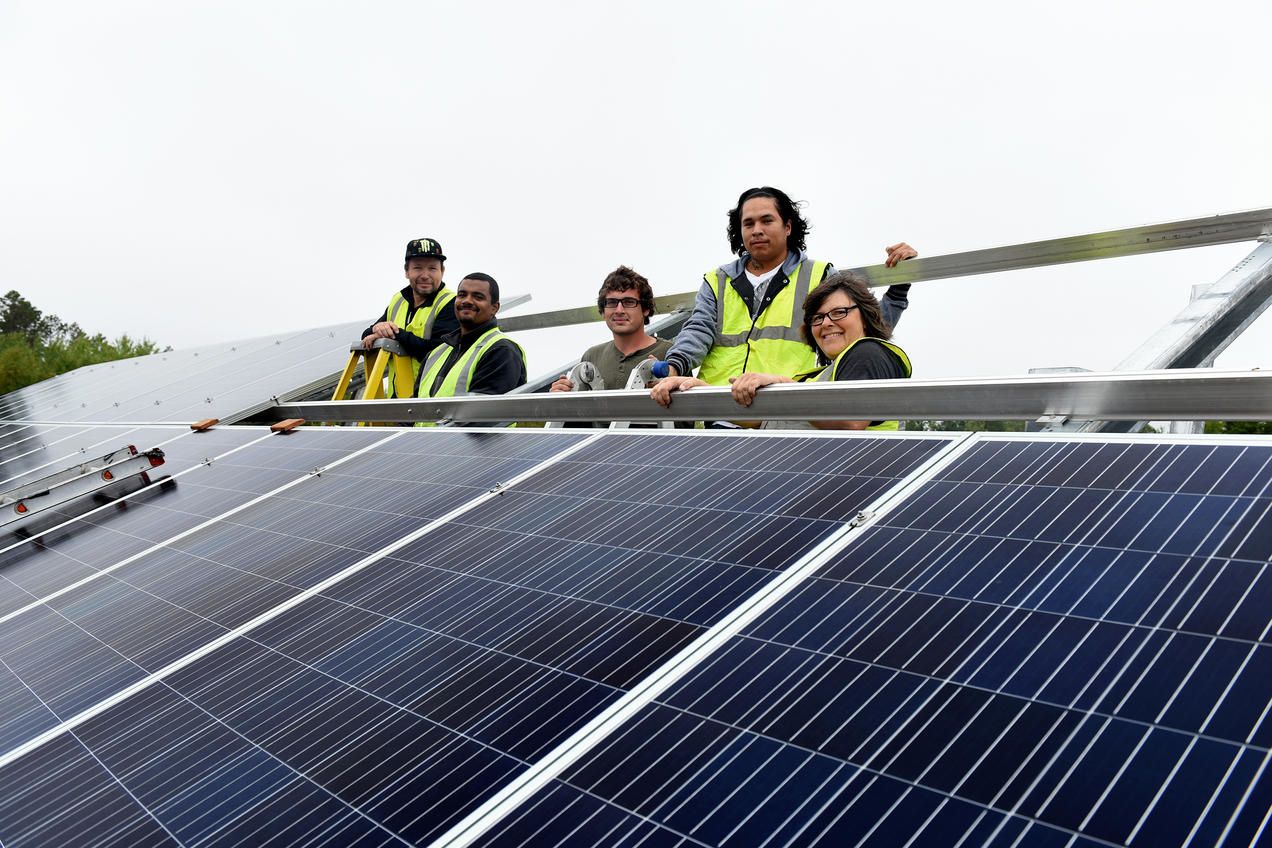
A Tribe in Northern Minnesota Shows the Country How to Do Community Solar

By Susan Cosier
Last summer on a reservation in northern Minnesota, students from Leech Lake Tribal College earned their solar installation licenses while they dug, drilled and connected five photovoltaic arrays. The panels shine blue on the plain, reflecting the sky as they generate roughly 235 megawatts of electricity a year, enough to help 100 families pay their energy bills. This is community solar in action.
Projects like this one are going up across the country and helping to diversify access to clean energy. Utility companies generate most U.S. solar power (about 60 percent), with the rest coming from rooftop setups on houses and other buildings. But for those who rent, own less sunny properties, or simply can’t afford an array of their own, community solar projects (or “solar gardens”) are an attractive option.
From the end of 2016 through 2017, the energy generated by such installations more than doubled nationwide, rising from 347 to 734 megawatts. Though they still account for just 1 percent of the solar market, community solar programs are currently working with 228 utilities in 36 states.
“Those people that are lower income also believe in renewable energy. They also believe in being better stewards of the earth,” said Brandy Toft, environmental deputy director for the Leech Lake Band of Ojibwe. “They want to do what they can, but they don’t always have the means.”
In a typical community solar arrangement, individuals and groups use a portion of the renewable electricity generated by arrays located nearby (on a church rooftop, a farm field, etc.). The rest of the electricity feeds into the grid, and the utility companies compensate solar garden subscribers with a credit on their energy bills.
So far, 29 states require utility companies to buy energy generated by renewable sources. Several strong community solar programs are emerging in the Midwest, said Samuel Garcia, a fellow of NRDC’s Climate & Clean Energy program. Illinois passed an energy law in 2016 establishing statewide community solar programs. Minnesota also has a statewide program, and Missouri regulators have approved the state’s first utility-initiated community solar project.
The Leech Lake project, however, is unique. Its completion last year marked the first time a community installed a solar garden to help residents in need, and it is part of the federal Low Income Home Energy Assistance Program (LIHEAP). The program, which distributes about $3.5 billion annually to offset heating and cooling expenses, began in the 1960s as part of President Lyndon B. Johnson’s war on poverty.
Energy assistance is “a safety net for families that can’t pay their energy bill,” said Jason Edens, director of Rural Renewable Energy Alliance (RREAL), a nonprofit that focuses on making renewable energy accessible to low-income populations. And that safety net is essential, because in the swelteringly hot or bone-chillingly cold corners of our country, having air-conditioning or heat can mean life or death.
About 42 percent of the 9,000 tribe members on the Leech Lake reservation live below the poverty line, but the tribe almost never receives enough LIHEAP money to help them all. Some residents don’t even bother applying for assistance. Further complicating matters, the organizations that distribute funds locally have trouble anticipating how much to expect because Congress makes different allocations each year. The problem extends beyond the reservation. Minnesota residents receive $116 million a year from the LIHEAP program, but just 20 percent of the eligible population receives funding, said Edens.
In 2015, Toft and Edens decided to do something about it for Leech Lake. Soon they were making inroads with fundraising efforts, figuring out which of Minnesota’s 170 utility companies or cooperatives they should work with, and finally handling price negotiations. In the end, about half the electricity generated by the solar arrays supplies the tribal buildings with electricity and the other half goes into the grid. The tribe gets an average of $0.09 per megawatt from the utilities, which comes to roughly $25,000 a year. At the end of the year, that money goes directly to the local energy assistance provider, allowing more households to get help keeping the lights and heat on.
Rural Renewable Energy Alliance workers and students and faculty of Leech Lake Tribal Collage, 2017.Ryan James White
“Now we know we have this revenue that’s helping our people,” said Toft. “We know we can pretty much count on it as long as the sun shines.”
The project also addresses a flaw in the energy assistance program—its reliance on carbon-intensive energy sources, like coal, that often fluctuate in price. Edens would like to more fully integrate solar power into the federal program and create a long-term, fiscally responsible, low-carbon solution that empowers families. But that, he said, could take significant investment from outside sources, as it did with Leech Lake.
The state of Minnesota and a number of donors, including the Minnesota Environmental and Natural Resources Trust Fund and the Bush Foundation, contributed $600,000 to the effort. That capital may not be available for every project, but what happened on the reservation is setting a great example for others. For instance, RREAL is currently working on another solar garden that helps supplement the energy assistance received by a low-income community in southern Vermont, and Edens said he will use the model in other places, too.
The Leech Lake tribe plans to replicate its success as well—installing two more arrays and bolstering the energy efficiency of 22 other buildings—including its community centers and its Northern Lights and White Oak casinos.
“I think this project was a catalyst, not only for future projects like it elsewhere but also for Leech Lake,” said Toft. And why not? Like the sun, solar power should shine for everyone.

 233k
233k  41k
41k  Subscribe
Subscribe 
